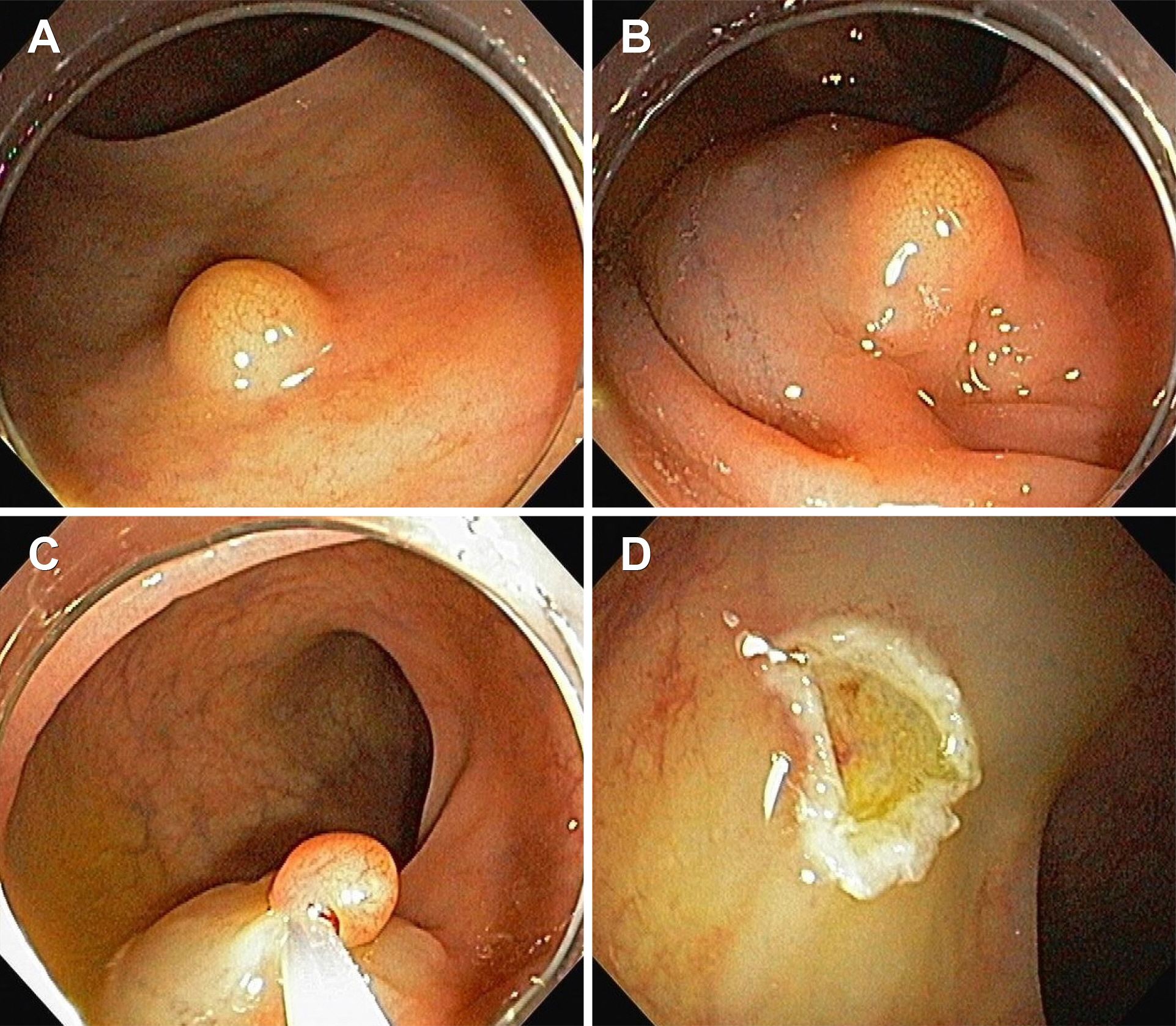Korean J Gastroenterol.
2018 Sep;72(3):128-134. 10.4166/kjg.2018.72.3.128.
Endoscopic Treatment Outcome of Rectal Neuroendocrine Tumors Removed by Ligation-assisted Endoscopic Submucosal Resection
- Affiliations
-
- 1Department of Internal Medicine, Yeungnam University College of Medicine, Daegu, Korea. dr9696@gmail.com
- KMID: 2420750
- DOI: http://doi.org/10.4166/kjg.2018.72.3.128
Abstract
- BACKGROUND/AIMS
Ligation-assisted endoscopic submucosal resection (ESMR-L) is preferred for the treatment of rectal neuroendocrine tumors because its results are better than those for endoscopic mucosal resection (EMR), and the procedure time is shorter and the incidence of complications is lower than endoscopic submucosal dissection. The aim of this study was to evaluate the clinical usefulness of ESMR-L compared with EMR for rectal neuroendocrine tumors.
METHODS
From March 2007 to May 2017, 148 patients diagnosed with rectal neuroendocrine tumors were divided into ESMR-L and EMR groups and analyzed retrospectively.
RESULTS
Of 148 patients with rectal neuroendocrine tumor, 120 had ESMR-L and 28 had EMR. The ESMR-L group had a significantly higher rate of complete resection and curative resection than the EMR group (93.3% vs. 75.0% and 92.5% vs. 71.4%, p=0.009 and p=0.003, respectively).
CONCLUSIONS
ESMR-L for the treatment of small rectal neuroendocrine is a significantly superior modality to EMR.
MeSH Terms
Figure
Reference
-
References
1. Cho MY, Kim JM, Sohn JH, et al. Current trends of the incidence and pathological diagnosis of Gastroenteropancreatic Neuroendocrine Tumors (GEP-NETs) in Korea 2000–2009: multicenter study. Cancer Res Treat. 2012; 44:157–165.
Article2. Scherübl H. Rectal carcinoids are on the rise: early detection by screening endoscopy. Endoscopy. 2009; 41:162–165.
Article3. Modlin IM, Oberg K, Chung DC, et al. Gastroenteropancreatic neuroendocrine tumours. Lancet Oncol. 2008; 9:61–72.
Article4. Mashimo Y, Matsuda T, Uraoka T, et al. Endoscopic submucosal resection with a ligation device is an effective and safe treatment for carcinoid tumors in the lower rectum. J Gastroenterol Hepatol. 2008; 23:218–221.
Article5. Kim HH, Park SJ, Lee SH, et al. Efficacy of endoscopic submucosal resection with a ligation device for removing small rectal carcinoid tumor compared with endoscopic mucosal resection: analysis of 100 cases. Dig Endosc. 2012; 24:159–163.
Article6. Kim YJ, Lee SK, Cheon JH, et al. Efficacy of endoscopic resection for small rectal carcinoid: a retrospective study. Korean J Gastroenterol. 2008; 51:174–180.7. Kim KM, Eo SJ, Shim SG, et al. Treatment outcomes according to endoscopic treatment modalities for rectal carcinoid tumors. Clin Res Hepatol Gastroenterol. 2013; 37:275–282.
Article8. Abe T, Kakemura T, Fujinuma S, Maetani I. Successful outcomes of EMR-L with 3D-EUS for rectal carcinoids compared with historical controls. World J Gastroenterol. 2008; 14:4054–4058.
Article9. Saha S, Hoda S, Godfrey R, Sutherland C, Raybon K. Carcinoid tumors of the gastrointestinal tract: a 44-year experience. South Med J. 1989; 82:1501–1505.10. Higaki S, Nishiaki M, Mitani N, Yanai H, Tada M, Okita K. Effectiveness of local endoscopic resection of rectal carcinoid tumors. Endoscopy. 1997; 29:171–175.
Article11. Soga J. Early-stage carcinoids of the gastrointestinal tract: an analysis of 1914 reported cases. Cancer. 2005; 103:1587–1595.12. Shirouzu K, Isomoto H, Kakegawa T, Morimatsu M. Treatment of rectal carcinoid tumors. Am J Surg. 1990; 160:262–265.
Article13. Matsui K, Iwase T, Kitagawa M. Small, polypoid-appearing carcinoid tumors of the rectum: clinicopathologic study of 16 cases and effectiveness of endoscopic treatment. Am J Gastroenterol. 1993; 88:1949–1953.14. Schindl M, Niederle B, Häfner M, et al. Stage-dependent therapy of rectal carcinoid tumors. World J Surg. 1998; 22:628–633. discussion 634.
Article15. Kobayashi K, Katsumata T, Yoshizawa S, et al. Indications of endoscopic polypectomy for rectal carcinoid tumors and clinical usefulness of endoscopic ultrasonography. Dis Colon Rectum. 2005; 48:285–291.
Article16. Onozato Y, Kakizaki S, Ishihara H, et al. Endoscopic submucosal dissection for rectal tumors. Endoscopy. 2007; 39:423–427.
Article17. Ono A, Fujii T, Saito Y, et al. Endoscopic submucosal resection of rectal carcinoid tumors with a ligation device. Gastrointest Endosc. 2003; 57:583–587.
Article18. Sakata H, Iwakiri R, Ootani A, et al. A pilot randomized control study to evaluate endoscopic resection using a ligation device for rectal carcinoid tumors. World J Gastroenterol. 2006; 12:4026–4028.
Article
- Full Text Links
- Actions
-
Cited
- CITED
-
- Close
- Share
- Similar articles
-
- Diagnosis and Management of Rectal Neuroendocrine Tumors
- Three Cases of Endoscopic Mucosal Resection of Rectal Carcinoid Tumor by Band Ligation and the Snare Resection Technique
- Recurrence after endoscopic resection of small rectal neuroendocrine tumors: a retrospective cohort study
- Endoscopic treatment for rectal neuroendocrine tumor: which method is better?
- Tips and Tricks for Better Endoscopic Treatment of Colorectal Tumors: Usefulness of Cap and Band in Colorectal Endoscopic Mucosal Resection



